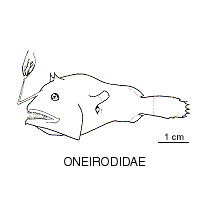- Classification
- ACTINOPTERYGII
- LOPHIIFORMES
- ONEIRODIDAE
-
Fish Classification
-
Class
ACTINOPTERYGII Ray-finned fishes -
Order
LOPHIIFORMES Anglerfishes -
Family
ONEIRODIDAE Dreamers
Family ONEIRODIDAE
More Info
|
Family Taxonomy |
This large family comrises 16 genera and at least 62 species. Three genera and 6 species are known from Australian waters. |
|
Family Distribution |
Found worldwide in all oceans, including polar regions, inhabiting meso- and bathypelagic waters between 300-3000 m. |
|
Family Description |
Females - highly variable in morphology, mostly short, deep-bodied, slightly compressed or globose with pair of large, horn-like (sphenotic) spines on top of head; some species are elongate and streamlined. Head short, eye small. Mouth large, opening horizontal to nearly vertical, jaws usually reaching well beyond eye; jaw teeth slender, recurved, depressible, highly variable in number, lower teeth longer than upper. Illicium ranging in length from very short and enveloped in escal tissue, to 75% body length; esca conspicuous, bioluminescent, simple to very complex. Three radial bones at pectoral-fin base, soft dorsal-fin rays 5-8 (very rarely 4), anal-fin rays 4-7 (very rarely 3), pelvic fins absent. Skin naked, dermal spines mostly absent. Males - free-living, much smaller than, but not parasitic on females. Jaw teeth absent, eyes and posterior nostrils directed laterally, anterior nostrils close together and directed anteriorly, olfactory organs large; skin naked. Males unknown for more than half the genera. |
|
Family Size |
Females to 370 mm; males to 28.5 mm. |
|
Family Feeding |
Reported to feed on fishes and crustaceans |
|
Family Reproduction |
Reproduction is oviparous, with pelagic eggs and larvae. Larvae not known for many genera. |
|
Family Commercial |
Of no commercial importance. |
|
Family Conservation |
None. |
|
Author |
Dianne J. Bray |
References
Bertelsen, E. 1951. The ceratioid fishes. Ontogeny, taxonomy, distribution and biology. Dana Rept. 39, 276 pp.
Munk, O. 1988. Glandular tissue of escal light organ in the deep-sea anglerfish Oneirodes eschrichti (Pisces, Ceratioidei). A light and electron microscopic study. Vidensk. Meddr. Dansk Naturh. Foren 147: 93-120.
Munk, O. & E. Bertelsen. 1980. On the esca light organ and its associated light-guiding structures in the deep-sea anglerfish Chaenophryne draco (Pisces, Ceratioidei). Vidensk. Meddr. Dansk naturh. Foren. 142: 103-129.
Pietsch, T.W. 1969. A remarkable new genus and species of deep-sea anglerfish (family Oneirodidae) from off Guadalupe Island, Mexico. Copeia 1969(2): 365-369.
Pietsch, T.W. 1974. Osteology and relationships of ceratioid anglerfishes of the family Oneirodidae, with a review of the genus Oneirodes Lütken. Nat. Hist. Mus. Los Angeles Co., Sci. Bull. 18, 113 pp.
Pietsch, T.W. 1975. Systematics and distribution of ceratioid anglerfishes of the genus Chaenophryne (family Oneirodidae). Bull. Mus. Comp. Zool. 147(2): 75-100.
Pietsch, T.W. 1978. A new genus and species of deep-sea anglerfish from the eastern North Pacific Ocean, with a review of the allied genera Leptacanthichthys, Chirophryne, and Ctenochirichthys (family Oneirodidae). Nat. Hist. Mus. Los Angeles Co., Contrib. Sci. 297: 1-25.
Pietsch, T.W. 2005. Dimorphism, parasitism, and sex revisited: modes of reproduction among deep-sea ceratioid anglerfishes (Teleostei: Lophiiformes). Ichthyol. Res. 52: 207-236.
Pietsch, T.W. 2009. Oceanic Anglerfishes: Extraordinary Diversity in the Deep Sea. University of California Press, 576 pp.
Pietsch, T.W. & Kenaley, C.P. 2005. Oneirodidae. Dreamers. Version 06 November 2005. http://tolweb.org/Linophrynidae/22027/2005.11.06 in The Tree of Life Web Project, http://tolweb.org/















